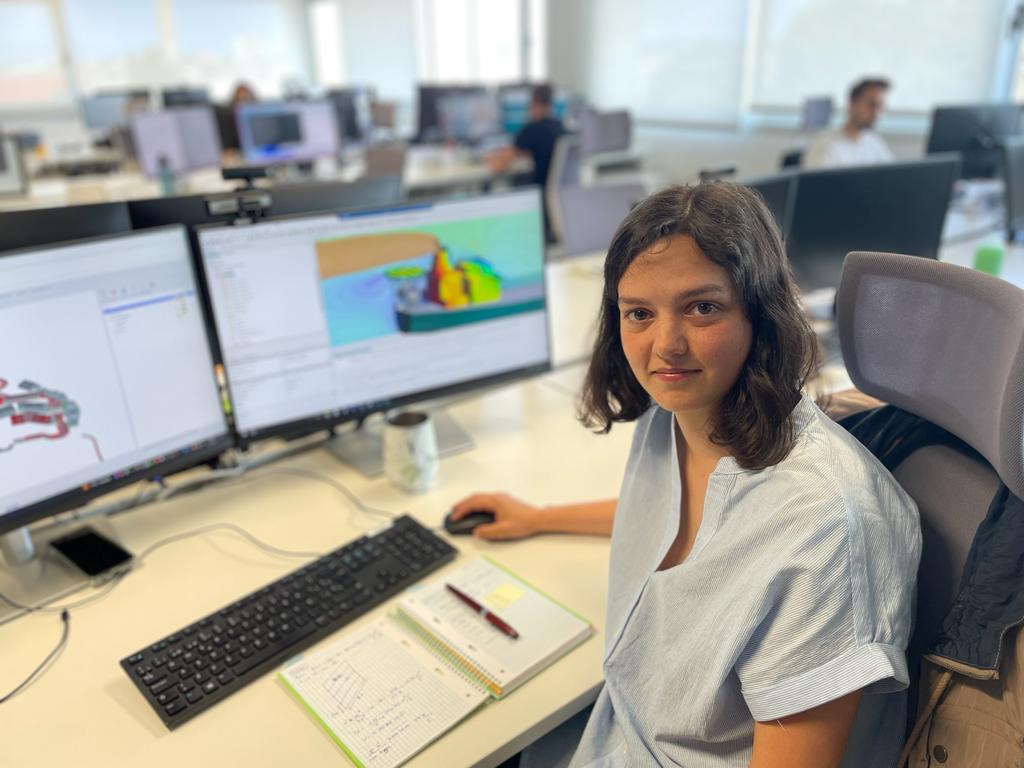
Contenidos
Iria, CFD Project Engineer in Aerodynamics
Industrial engineer specilize in aerodynamics working in VICUS for 4 years now.
Q: You have a background in industrial engineering and have pursued two master’s degrees related to Computational Fluid Dynamics (CFD). What motivated or connected you to steer your career towards the study of hydrodynamics and aerodynamics?
A: I have always been interested in physics and mathematics, and as I progressed in my studies, I discovered that by applying the right equations, we can model and understand what happens in nature. I was fascinated by the fact that two fluids, air and water, dominate in nature, and that engineering could make this world more sustainable. That’s how I delved into the field of hydrodynamics and aerodynamics.
Q: During your Erasmus experience in Sweden, what skills or knowledge do you think have helped you in your professional career?
A: I studied at Luleå University of Technology in Sweden, where I worked on various CFD projects and experimental tests that helped me establish the foundations of the specialization I currently work in.
Q: How would you describe CFD in a sentence, and how is it applied in the naval sector?
A: In practical terms, CFD is based on creating a virtual model of a system, applying several conditions, and simulating different scenarios to evaluate what would happen. Everything is simulated virtually, allowing us to anticipate potential problems and improve design efficiency before it is manufactured. This technique is particularly useful in the naval sector, where aerodynamic and hydrodynamic calculations are performed, as well as two-phase simulations that combine both air and water fluids.
Aerodynamic calculations are applied to the above-water part of the ship, analysing the dispersion of exhaust gases, studying thermal comfort, or assessing the feasibility of helicopter landings on the ship’s helideck.
Regarding hydrodynamics, we conduct studies on resistance, self-propulsion, or power prediction for the part of the ship that is in contact with water. We also analyse propulsion elements such as propellers, ESD (Energy Saving Devices), and other propulsion components to ensure their design is as efficient as possible.
When it comes to studies that combine water and air, the focus is on predicting manoeuvres by simulating the ship in different trajectories, as well as examining the behaviour of the ship under different sea conditions and wave states to evaluate its acceleration capabilities in those conditions.
Q: How is the airflow in a helipdeck modelled and simulated using CFD?
A: To model and simulate the airflow in a helideck using CFD, the first step is to create a 3D model of the ship. Specifically, we focus on the above-water structure, including the superstructure, chimneys, the part of the hull above the waterline, and the helideck. Next, we apply different environmental conditions, such as wind intensity and direction, as well as ship operation conditions, including emissions from engines, boilers, and auxiliary motors.
Subsequently, we perform a series of simulations with all scenarios, calculating the thermal and turbulence variations in the helideck area. According to current regulations, if the temperature or turbulence exceeds certain limits compared to the given values, it may not be safe for helicopters to land. Therefore, in addition to considering the ship’s shape, we also consider the type of helicopter, as not all helicopters have the same capabilities.
Q: How is the stability and safety of helicopters ensured when landing and taking off on a fly-deck using CFD?
A: Helicopters are inherently unstable machines, and any disturbance, whether thermal or turbulent, can cause them to become unbalanced. To determine when it is safe to land and when it is not, we create a summary table for the pilot and landing operator, differentiating between three states: severe, moderate, and no effect. In severe conditions, due to significant temperature or velocity instabilities, the helicopter should not land when those specific conditions of wind and ship operation are present. Under moderate conditions, the helicopter can land with assistance, which can be provided by the operator on the flight deck or mechanically, using ropes that connect the helicopter to the ship. The third scenario is a safe landing where there should be no issues with the manoeuvre.
Q: What would you say are the critical points to consider in aerodynamics when designing ships?
A: In aerodynamics, there are three critical points that must be considered: the helideck, thermal dissipation, and comfort.
For fly-decks, as mentioned earlier, CFD studies must be conducted to comply with safety regulations for landings, designing the helideck location to allow safe landings in various scenarios. The second aerodynamics concern relates to exhaust gases, and to ensure that there are no interferences with electronic devices, it is important to study their movement and trajectory. Lastly, passenger and crew comfort on the deck must be ensured. Studies are conducted to measure pollutant concentrations and comply with regulations.
Q: In which types of ships would you say it is crucial to carry out aerodynamic or exhaust gas studies? What are the most common problems for each of them?
A: In passenger ships such as yachts or cruise ships, we often perform comfort studies and dispersion analysis of microscopic solid particles (which can deposit on the deck and be pollutants). We conduct aerodynamic studies on warships to ensure they meet the RADAR (Radio Detection And Ranging) signature, making them undetectable to other ships during combat.
We also conduct studies on offshore assistance platforms and oceanographic vessels used for research, as they have sensors that can be affected by excessively hot airflow.
Q: What projects are you currently working on?
A: Currently, I am conducting a study on a warship to control the RADAR signature, ensuring that smoke dispersion does not exceed a certain temperature in the sensors and radars. Additionally, I am monitoring turbulence, temperature, and gases on the deck. I am also conducting a ventilation study for the same warship, calculating aerodynamic losses and acoustic attenuation in the ventilation ducts.
Moreover, although Vicus primarily focuses on the naval sector, we also work in the energy industry. We are currently conducting a study for a Waste-to-Energy Plant, evaluating the thermal conditions in various areas containing operating machinery. The goal is to calculate heat dissipation and ensure proper ventilation to comply with temperature regulations in all areas of the plant.
Q: What has been the most challenging project you have worked on at VICUS as a CFD engineer? How did you approach it, and what did you learn from it?
A: We faced a significant challenge in a warship project where we simulated the missile launch from one of the decks to prevent the ship from becoming blind due to gas emissions during the launch, which could affect radars, engines, weapons, and ventilation. The difficulty lay in modelling the extreme temperature and pressure conditions under which the missile gases emit, which are not typical.
Q: What part of your work do you find most passionate about?
A: What I enjoy the most is building a model from scratch and figuring out which equations and conditions are necessary to reproduce what is happening as realistically as possible. I also take pleasure in helping our clients predict what will happen before it is too late. Through CFD simulations, they can make redesigns to avoid problems and improve the efficiency of their equipment, which would not be possible through any other means.
Q: How has CFD evolved in the naval sector in recent years, and what improvements do you expect in the future?
A: Computational power has significantly evolved in recent years. Computers are now more powerful than before, allowing us to create full-scale and more complex models to achieve the most realistic simulations possible. New physical models that were previously unsimulated due to limitations are now incorporated into the software we use. This allows us to simulate phenomena that were not possible before.
At Vicus, we are developing automation and optimization systems that support ship design. Advances in this field help reduce the time required for simulation processes and post-processing, as well as minimizing human errors.
